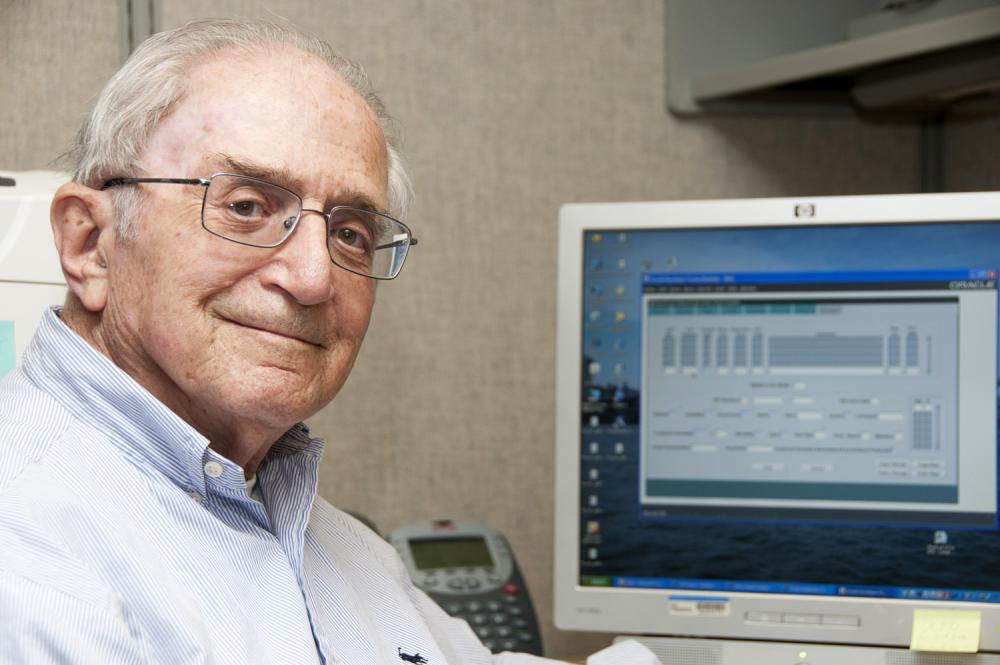By Ashley DeVine, Staff Writer
Can you imagine working for the same company for 50 years? Nathaniel “Ned” Greenberg has accomplished just that, having recently received his 50-year service award from NIH, and he has no immediate plans for retirement.
“I don’t look upon my job as a chore, it’s more of an avocation than a vocation,” said Greenberg, a chemist in the Biological Testing Branch (BTB), under Branch Chief Melinda Hollingshead, DVM, Ph.D. “I am lucky that I found something that I enjoy doing.”
Beginning a Career at NCI
He began working at the National Cancer Institute (NCI) in 1961 at the Clinical Center in Bethesda, in the Biochemical Pharmacology Section. “The doctor that I worked for was studying resistance of a tumor to methotrexate, which is a drug used in cancer therapy, and what we did was make a tumor resistant, measure the level of dihydrofolate reductase as resistance developed, and then stop treating and watch the enzyme levels decrease,” Greenberg said of some of his research. The goal of this research was to find out what happens when a tumor becomes resistant to a drug.
Greenberg worked with several international scientists during his time in the Biochemical Pharmacology Section. He remains friends with one of the scientists he met from Poland, who is a member of the Polish Academy of Sciences.
Moving Out of the Lab
In 1966, Greenberg transferred to the Cancer Chemotherapy National Service Center (an extramural NCI group). He became a project officer in the Screening Section of the Drug Evaluation Branch. He was overseeing two to three in vivo contract laboratories and one in vitro contract laboratory.
“I helped compile a list of all the in vivo and in vitro test systems, and this was published in Cancer Chemotherapy Reports in 1972. An update was printed as an NIH publication in 1984,” Greenberg said.
It was in 1966 that Greenberg stopped working in the lab, and he hasn’t returned since. “I gave up biochemistry and started to evaluate drug activity in the tumors,” he said.
To evaluate drug activity in tumors, Greenberg explained, researchers look at rodent tumor models, where one group of animals is the control group (tumors are not treated with a drug), and the other group is treated (tumors are treated with a drug). Depending on whether the tumor model is based on tumor weight or animal survival, a calculation is used to determine if the effect of the drug on tumor weight or animal survival means that the drug is active in the tumor model or not.
The drugs/chemicals tested in the Screening Section consisted of natural product extracts, submissions from the public, samples from college chemistry laboratories, and products obtained through agreements with pharmaceutical companies. If the drugs showed activity, they were developed further within NCI.
Transferring to Frederick
Greenberg transferred to BTB at Fort Detrick in 1986, where he continues to work today. His job still involves evaluating drug activity in tumor systems. He began entering test data from the laboratory into the computer system around 1989. “The program is more selective now regarding what compounds are selected for testing than it was when I was a member of the Screening Section,” Greenberg said. Beginning in 1987, compounds tested at BTB were first tested in a 60-cell in vitro screen. If the compounds showed promise, they were tested in vivo.
“In the early 1990s, Dr. Hollingshead developed the hollow fiber assay, and it was inserted between the in vitro assay and in vivo testing. If a material was active in that assay, a committee would recommend in vivo xenograft testing,” Greenberg said. This process continues today.
Over the years, Greenberg has contributed to the scientific community in ways in which he is proud. In the 1970s, he helped disprove that a material (Laetrile) used in Mexico was the cure for cancer. He also recalled working 24 hours straight when testing a drug called cytosine arabinoside, which had to be injected intraperitoneally into mice every three or four hours.
Although Greenberg’s job duties may not have changed greatly since 1966, the work environment certainly has. “I had my fingers in more drugs [prior to 1986] than I have here,” he said. “The members of the Screening Section were intimately involved in the testing of every compound.”
Greenberg appreciates being recognized for 50 years of service, but noted that “finding a drug that’s active against cancer is enough of an award.”


